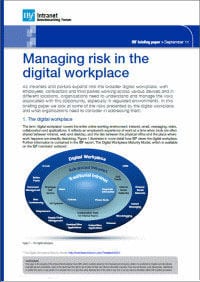Managing Risk in the Digital Workplace
DWG’s latest research paper investigates the challenges facing intranet and digital workplace managers and organisations as digital working reaches critical mass.
As intranets expand into the digital workplace, organisations are presented with new opportunities to communicate, collaborate and share information more quickly and freely both internally and with business partners. With these opportunities the challenge of managing the potential risks is also increased as the channels for monitoring and compliance are multiplied, often across a number of platforms.
 These risks include dependency on externally hosted applications and services, the increasingly free flow of information inside and between organisations, and less control over the physical workplace. One thing these risks share is the move from tight central control to a more distributed model for content creation and service delivery, and what that means for organisations in terms of the opportunities and risks they face and the way they approach and manage them. The changing digital environment is having an impact on a range of organisations from SMEs taking advantage of free or low-cost hosted applications such as Google docs, through to the largest enterprises with estates of corporate-issued, and increasingly, consumer-purchased portable devices.
These risks include dependency on externally hosted applications and services, the increasingly free flow of information inside and between organisations, and less control over the physical workplace. One thing these risks share is the move from tight central control to a more distributed model for content creation and service delivery, and what that means for organisations in terms of the opportunities and risks they face and the way they approach and manage them. The changing digital environment is having an impact on a range of organisations from SMEs taking advantage of free or low-cost hosted applications such as Google docs, through to the largest enterprises with estates of corporate-issued, and increasingly, consumer-purchased portable devices.
Google itself has not been immune to the challenges around information security and privacy, facing a class-action lawsuit concerning Buzz in 2010 and Facebook faced similar legal proceedings over changes to its use of personal information.
In the “Managing risk in the digital workplace” briefing paper we look at some of the risks organisations are facing from increased use of mobile devices and remote working through to that posed by inaccurate or out of date content:
- Security for mobile devices storing sensitive corporate data or providing access to enterprise systems and information
- Vendor security and risk ownership when working with third parties for application hosting, data storage or service provision
- Privacy and security lawsuits from individuals and organisations alleging breaches of legislation concerning the use and protection of their information.
- Inaccurate or inappropriate information published by employees on internal and external company communication channels such as websites, instant messenger, microblogging tools etc.
We also explore some of the emerging best practice and guidance in this area from legal experts and government organisations as well as private sector organisations. The full report includes a detailed case study from DWG member organisation BT on how they manage content risks, as well as expert advice and opinion from privacy lawyer David Navetta on the main issues facing organisations and ownership of risk.
DWG members can download this briefing paper, and access our full research archive, on the IBF extranet.
This is a guest post from Andrew Marr. Andrew is an IBF lead benchmarker, research associate and independent business consultant with over 12 years’ experience in online strategy, analysis, development and management. Among other things, Andrew managed Bupa’s intranet for a number of years, implementing pioneering social and collaboration applications during that time.
Categorised in: Uncategorized
